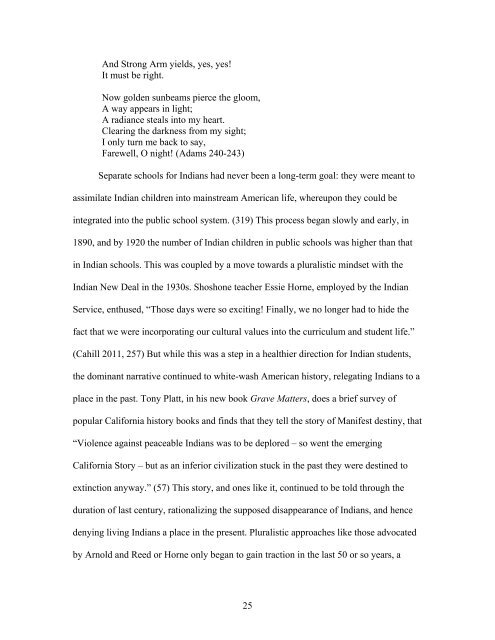The Intersection of Karuk Storytelling and Education
The Intersection of Karuk Storytelling and Education
The Intersection of Karuk Storytelling and Education
Create successful ePaper yourself
Turn your PDF publications into a flip-book with our unique Google optimized e-Paper software.
And Strong Arm yields, yes, yes!<br />
It must be right.<br />
Now golden sunbeams pierce the gloom,<br />
A way appears in light;<br />
A radiance steals into my heart.<br />
Clearing the darkness from my sight;<br />
I only turn me back to say,<br />
Farewell, O night! (Adams 240-243)<br />
Separate schools for Indians had never been a long-term goal: they were meant to<br />
assimilate Indian children into mainstream American life, whereupon they could be<br />
integrated into the public school system. (319) This process began slowly <strong>and</strong> early, in<br />
1890, <strong>and</strong> by 1920 the number <strong>of</strong> Indian children in public schools was higher than that<br />
in Indian schools. This was coupled by a move towards a pluralistic mindset with the<br />
Indian New Deal in the 1930s. Shoshone teacher Essie Horne, employed by the Indian<br />
Service, enthused, “Those days were so exciting! Finally, we no longer had to hide the<br />
fact that we were incorporating our cultural values into the curriculum <strong>and</strong> student life.”<br />
(Cahill 2011, 257) But while this was a step in a healthier direction for Indian students,<br />
the dominant narrative continued to white-wash American history, relegating Indians to a<br />
place in the past. Tony Platt, in his new book Grave Matters, does a brief survey <strong>of</strong><br />
popular California history books <strong>and</strong> finds that they tell the story <strong>of</strong> Manifest destiny, that<br />
“Violence against peaceable Indians was to be deplored – so went the emerging<br />
California Story – but as an inferior civilization stuck in the past they were destined to<br />
extinction anyway.” (57) This story, <strong>and</strong> ones like it, continued to be told through the<br />
duration <strong>of</strong> last century, rationalizing the supposed disappearance <strong>of</strong> Indians, <strong>and</strong> hence<br />
denying living Indians a place in the present. Pluralistic approaches like those advocated<br />
by Arnold <strong>and</strong> Reed or Horne only began to gain traction in the last 50 or so years, a<br />
25
















